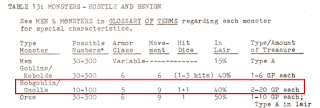
Here's another poll I asked on the ODD74 forums: Do Hobgoblins and Gnolls count as normal man-types?
What does that even mean?, you might possibly say. In OD&D circles, there are frequent rules debates on whether something counts as "normal" or "fantastic" (that is, not-normal) or not. This springs from the Chainmail Fantasy Supplement, where some types just borrowed the combat dice mechanic from the mass-combat game (e.g., hobbits, dwarves, elves, goblins, orcs), and others did not, appearing with special custom rules on the "Fantasy Combat Table" (e.g., heroes, wizards, dragons, trolls, giants). Sometimes those latter "fantastic" creatures were immune to "normal" attacks and sometimes not; sometimes they also had parallel values for the normal mass-combat mechanics, and others did not.
So there's a hazy border area about what monsters are "normal" and what are not. And this distinction flows directly into the Original D&D rules, where some spells and magic items (e.g., charm person, hold person, potion/ring of human control) implicitly work just on the "normal" types. Furthermore, fighters throughout the Chainmail-0E-1E-2E rulesets are given a cleave-ability of attacks per round equal to their level, but only against "normal" types (the definition of which varied slightly over the editions).
Therefore, in the hazy state of OD&D, the Hobgoblin/Gnoll types jumped out at me as existing right on the boundary of the normal/fantastic parameters, and I was wondering which side of the fence most OD&D players placed them on. Hobgoblins don't appear on the Chainmail Fantasy Combat Table; Gnolls don't appear in those rules at all. In OD&D they appear jointly on a single line of the monster roster. Hobgoblins have hit dice 1+1, Gnolls have 2, which in some definitions ("base 1 hit die or less", Gygax's FAQ in The Strategic Review #2) would put them on opposite sides of the divide, which could seem odd. On the other hand, the OD&D charm person spell is said to affect all these types up to Gnolls explicitly, and critically on the monster list, hobgoblins/gnolls are the highest type to appear in mass numbers into the hundreds (implying that the fighters' cleave-ability was meant to work against them)?

As you can see in results at the top, the majority of respondents on the ODD74 forums said, "yes", Hobgoblins and Gnolls should count as "normal men" for these kinds of purposes (even though they both have more than 1 single hit die). Twelve people (80%) voted "yes", and only three people (20%) voted "no". As usual here: a small sample size, but a lopsided majority for "yes".
I agree that does seem to make the best regression between various signals in different parts of the rules (charm person inclusion, mass numbers appearing, formation status in Swords & Spells, etc.). However, in my own house rules, I lean towards saying "no". It seems much more elegant to say "man-size is anything up to 1 hit die". That complies with the stated fighter-cleave requirements, restricts to actual man-sized figures (gnolls in AD&D are said to be 7+ feet tall!), and generally gives a nice easy-to-remember cutoff.
Here's the real kicker, though. As part of the discussion on ODD74, user retrorob pointed out a detail that all the rest of us missed: in the Beyond This Point Be Dragons document (BTPBD), presumed to be a copy of a pre-publication original D&D draft -- get this -- even Gnolls did have a single hit die! In this work, there is absolutely no mechanical distinction between the two types, except for either +1 or +2 morale bonus given in the descriptive text. Thanks immensely for that, retrorob!

So that sort of comes back full circle. Assuming the BTPBD is an accurate reflection of the original design, the "normal" monster types affected by charm person, hold person, fighter cleaving, mass numbers appearing, etc. really did top out at base 1 hit die (including hobgoblins/gnolls at 1+1 hit dice). Having observed that, the elegance of such a system attracts me so much that I kind of want to declare that the true rule for my games. If we keep Gnolls at 2 hit dice for variety, then presumably we'd want to keep them off the fighter-cleave list, reduce their large Numbers Appearing, and cut them off the charm/hold person effect lists, etc. Suddenly that looks really nice to me. (And by implication, later 2 hit die creatures like Lizard Men and Troglodytes would be in the same category.)
How would you have voted there?
Poll on Hobgoblin/Gnolls at ODD74 (account required)
















